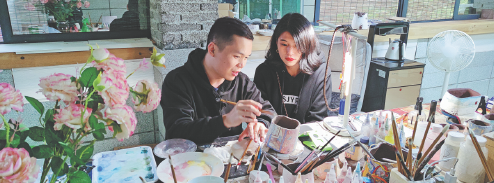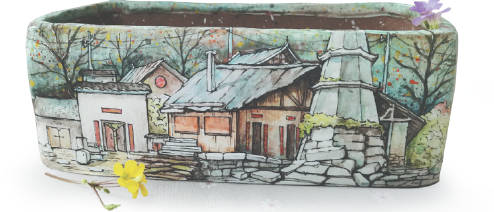Homing in on success
Designer learns pottery to reproduce scenes from his village in Hunan, Yang Feiyue reports.

Women in ethnic clothing and accessories, some countryside scenery and birds in a bamboo forest all appear on Tan Xianqi's pottery works.
The 30-year-old from a small village in Jingzhou Miao and Dong autonomous county, Central China's Hunan province, has drawn inspiration from his hometown and turned the images into artistic expressions.
"The distinctive ethnic culture, food and architecture are nothing if not appealing," Tan says.
The silverware with engraved patterns of Miao people, brocade works and the Fengyu ("wind-rain") Bridge that is a unique example of construction by the Dong people are among the essence of traditional culture in Jingzhou.
Since he went to study art design at Heilongjiang University in Harbin, Northeast China's Heilongjiang province, in 2011, the village scenes have appealed to Tan.
"I love art and so decided to leave home for college to explore other regions of the country for inspiration," Tan says.
He picked up interior design and looked into features of ancient and modern Chinese architecture, as well as art history from home and abroad.
"It has given me new perspectives toward things back home," Tan says. "If anything, I developed more appreciation for the village's beauty."
His bond with Jingzhou grew stronger as he returned during the summer and winter vacations and acquired internships as a teacher at a local art-training facility.
"I used my experience to help prepare local students who went on to pursue arts in college," Tan says.
In his interactions with the students, he developed his own way of teaching art, which not only gave him a sense of achievement but also endeared him to people around.
"When teaching, I saw things from the students' perspective, encouraged them to paint about various ideas, and they were responsive to my approach," Tan says. "I was a bit reluctant to leave when the vacations were over."
Tan was faced with a tough choice in his senior year when many companies from Harbin and Beijing visited his school for hiring.
"Like most of my classmates, I went for some interviews and got several job offers," Tan says.
Yet, an inner unease weighed on his mind.
"I have a reserved personality, and it's more suitable to things back home, and I didn't know if I would be up for life in a big city," he says.
But he knew if he took one of the job offers, it would be likely that he would settle down in the big cities.
Interior designers have to work in one place to accumulate years of experience to develop a local clientele, he explains.
As he was torn between the two options, a local teacher in the village whom he had known during his internships called Tan to ask if he could return and become a teacher for primary and middle school students.
"Although the pay was about half of that in big cities, I knew it would be an opportunity closer to my heart," Tan says.
"I could return home and enjoy more room for my own art creation," he says, adding that he was also confident of being a good art teacher.
In 2015, Tan went back to Jingzhou after graduation and worked as an art teacher. In his spare time, he painted and explored other forms of art. In 2019, when he was seeking a breakthrough in his watercolor paintings, his school introduced a pottery class.
When he saw the pottery teacher molding and firing pottery, the idea of creating watercolor paintings on the pottery struck him.
"The pigment carries its original color when you put it on a piece of paper, but the color changes when you fire it for the pottery," he says.
That was when he embarked on a journey of integrating watercolor elements with pottery, which was a new world to him. At the beginning, Tan often botched his earthenware, most of which either collapsed or showed defects on the surface during firing.
"It was frustrating, when the watercolor patterns I took pains to paint were spoiled on the pottery items I made," he says.
But he persisted, allured by the rich layers of watercolor expression on clay. He then decided to learn pottery at the Jingdezhen Ceramic Institute in the "hometown of Chinese ceramics" in Jiangxi province in 2020.
He learned how to select clay, mold and paint, as well as find the right temperature for firing pottery. After grasping all the necessary techniques, Tan got down to making things. He first settled on the optimal temperature for local clay in his hometown and the right color through trial and error after he returned later that year.
"The local clay contains levels of impurities different from Jingdezhen, such as iron, which would warp and show lumps under the wrong firing temperature," he says.
Then, he applied elements of his hometown on pottery works through the watercolor style.
"It was perfect for me to show nostalgia with the smudging and various shades rendered by pigment and water," Tan says.
To his surprise, the residents of his village began to approach him after seeing his works on display.
"Most of them lived in the city and came for holidays," Tan says. "They were drawn to the scenes of our hometown and interested in taking them back."
Then, by word of mouth, more people came to buy, and the popularity of his works made its way to the internet. More people got to know about Tan's works from short-video platform Douyin and online shopping platform Taobao.
To date, Tan has sold more than 1,000 pottery works, a majority of which feature aspects of Jingzhou. As his business grew, Tan started to hire local villagers for help. He also offered training.
Yang Shenglan is among three locals who have been working for Tan. The 30-year-old was a stay-at-home mother.
"I love painting, and Tan said he would teach me, so I came," Yang says.
So far, Yang has been able to paint simple patterns on pottery works. The job offers her a monthly salary of 5,000 yuan ($751).
At the moment, Tan's workshop can produce about 60 pieces of pottery, mostly decorative items, such as vases and tableware, every month. Tan has also started to take customized orders, with people from other parts of the province visiting him with photos of designs they'd like to be on pottery works.
Tan says positive feedback from his customers help him to carry on with what he does. There's a sense of fulfillment, he says, adding that he will keep providing "a piece of hometown" for people to remember.

































